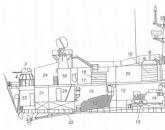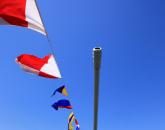Reproduction and development of animals presentation. Lesson of the world around "reproduction and development of animals"
"The world"
Presentation for the lesson
Teacher: Slepneva V.L.
MBOU Balaganskaya secondary school No. 2

insects
fish
amphibians
groups animals
reptiles
birds
mammals

In what groups can animals be combined, given what they eat?
- herbivores (feeds mainly on plants)
- Carnivores (eat other animals)
- omnivores
(they also eat plants)
and animals)

In what groups can animals be grouped according to their ability to live and breed in captivity?
- Wild animals
- Pets

What groups can all animals be divided into according to the method of reproduction?
- amphibians
Spawning in the water
Oviparous
viviparous
- fish
- insects
- reptiles
- birds
- Mammals (animals)


Insects are dioecious inhabitants of our planet, that is, among them there are males and females.
The male is different from the female.
Like this pair of stag beetles, for example.

Perhaps the difference is the brightness of the color. For example, lemon butterflies: the male's wings are lemon-yellow, the female's are greenish-white.

Consider the stages of development of insects using the example of an admiral butterfly.
BUTTERFLY ADMIRAL

1. A female butterfly laid an egg on a leaf of a host plant.
2. Soon a larva (caterpillar) will appear from the egg. The caterpillar will feed heavily, grow, molt.



BUTTERFLY
PUPPET
CATERPILLAR
LARVA

BUT!
Among insects, there are also those that do not have a pupa, and the larva looks like an adult insect.
GRASSHOPPER
DRAGONFLY


Consider the reproduction and development of fish on the example of pink salmon.
pink salmon female
male
during the mating season

1. In spring, the female spawns eggs into the water, and the male waters her with milk.

2. A larva can develop from each individual egg.
3. A fry develops from a larva.


chick
Egg
adult bird

! Peculiarities !
- All birds breed on land.
- Most birds build nests.
- Birds incubate the eggs, warming them with the warmth of their bodies.
- Parents feed the chicks and protect them from enemies.

live cubs
adult animals

! Peculiarities !
- Mammals give birth to live babies.
- The mother feeds them with milk, takes care of them, protects them, teaches them to get food, to defend themselves from enemies.

Lesson summary
- What is the name of a butterfly larva?
Caterpillar
- What develops from a fish larva?
fry
- What are the similarities between bird and insect reproduction?
Lay eggs
- What are the similarities between bird and mammal reproduction?
Take care of offspring
Class: 3
Presentation for the lesson
Back forward
Attention! The slide preview is for informational purposes only and may not represent the full extent of the presentation. If you are interested this work please download the full version.
Class: 3.
Lesson objectives:
- To acquaint students with the features of reproduction of animals of different groups.
- To form an idea of the sequence of development of animals of different groups.
- During the lesson, curiosity, coherent speech develops; the ability to reason, observe, generalize, draw conclusions, and work in pairs.
Equipment:
- Computer.
- Media projector.
- Power point presentation.
- Tables of development of representatives of different groups of animals.
During the classes
I. Presentation of the topic of the lesson.
We need a new shirt. What are we doing? (We buy a new shirt or we sew it ourselves.)
We need grass on the lawn in front of the house in the country. What are we doing? (We sow seeds, grow, water.)
- Right to get new item, a person makes it from other materials. To get a new plant, we grow it: we sow seeds, plant bulbs, bury tubers, take offshoots, etc. (depending on the method of reproduction).
Animals, like all other living beings, reproduce. Today we will talk about what features of reproduction and development are characteristic of different groups of animals.
II. Preparation for the perception of new material, repetition of the previously studied.
- Let's remember what main groups scientists combine animals into. (Insects, fish, birds, reptiles, amphibians, mammals. And also worms, molluscs, arachnids, crustaceans.)
- And in what groups can animals be combined, given what they eat? (Herbivorous, carnivorous, omnivorous.)
- Give examples.
slide 3- In what groups can animals be grouped according to their ability to live and breed in captivity? (Wild and domestic animals.)
- And my next question will lead us to new topic. Let's try, remembering the previous material, to answer the question: what groups can animals be divided into, given the methods of reproduction? (Oviparous; animals that spawn in water; viviparous.)
III. Learning new material: Reproduction and development of insects.
Slides 6-14- Insects have males and females. Thus, insects are dioecious inhabitants of our planet. Like most species of living creatures, males and females of insects have differences that can be expressed, for example, by bright colors, sizes - males are most often larger, but there are exceptions.
This, of course, is necessary so that the female and male can find each other. Different insects search in completely different ways. Someone sings serenading songs, and someone glows like a small flashlight, like, for example, fireflies. Some insects emit odors, sometimes fragrant (pigtails smell like lemon leaves), and sometimes not very pleasant to the human nose.
So, the female and the male found each other. The female laid eggs.
I think now it's time to find out how it will happen further development future insect.
I propose to observe a butterfly called admiral.
Having laid an egg on a leaf of a fodder plant, the female is no longer worried about the future fate of her offspring. She does not watch how a larva appears from an egg (in butterflies it is called a caterpillar). This is a very voracious creature that is not at all like its parents. The caterpillar feeds intensively, grows and molts.
After some time, the next stage of development will come: the caterpillar will turn into a chrysalis. This is indeed a motionless chrysalis, which is attached to the surface of the leaf and is waiting for the next stage - the appearance of an adult insect.
- So, let's create an insect development scheme using the admiral butterfly as an example. (Egg, caterpillar, pupa, adult insect.)
- It should be noted here that not all insects follow this path of development. Among the representatives of this group of animals, there are also those that do not have a pupal stage, and the larva looks like an adult insect. For example, these are grasshoppers and dragonflies.
IV. Learning new material: Reproduction and development of fish.
- To have an idea about the reproduction and development of fish, let's take a closer look at the life of pink salmon. During the mating season, the color of the male pink salmon changes, the jaws are bent, and a hump grows on the back. The female does not change.
The female lays eggs in the water, and the male waters her O kami. Each individual egg can develop into a larva. A fry develops from a larva, and an adult fish develops from a fry.
Slides 15-19V. Learning new material: Practical work in pairs.
- Compare larva, fry, adult salmon fish. Find similarities and differences.
VI. Learning new material: Reproduction and development of birds.
- Let's based on our life experience, let's try to make a chain of bird development. (Egg, chick, adult bird.)
- Well done! And here it is necessary to pay attention to the following features of the development of birds.
- All birds breed on land.
- Most birds build nests.
- Birds incubate the eggs, warming them with the warmth of their bodies.
- Parents feed the chicks and protect them from enemies.
VII. Learning new material: Reproduction and development of mammals.
– We have just concluded that birds are a very interesting group of animals that take care of their offspring. And what other group of animals takes care of their offspring? (Mammals.)
- Right. Let's make a conclusion.
- Mammals give birth to live babies.
- The mother feeds them with milk, takes care of them, protects them, teaches them to get food, to defend themselves from enemies.
VIII. Summary of the lesson.
- What is the name of a butterfly larva? (Caterpillar.)
- What develops from a fish larva? (Malyok.)
- What are the similarities between bird and insect reproduction? (Lay eggs.)
- What are the similarities between bird and mammal reproduction? (Take care of offspring.)
The images used in the presentation are from .
Reproduction and development of animals.
Animals, like all living things, reproduce. insects birds amphibians mammals fish
4. Pupa of the monarch butterfly just before the appearance of the butterfly. 3. The caterpillar makes itself a hard cocoon called a chrysalis. 2. Monarch butterfly caterpillar. The larva hatches from the egg and remains in this state for about two weeks. Stages of butterfly development: The butterfly lays its eggs on plants. 5. Adult female monarch butterfly.
The chrysalis is like a safe that protects the body of an insect. - The babies that hatch from insect eggs are called larvae, although they are often called simply caterpillars. - The caterpillar grows so fast that its skin is cracked, and under it there is already a brand new skin designed to grow. - A female butterfly lays 50,000 eggs in her lifetime. - Butterfly does not grow, but it likes to drink sweet flower nectar from time to time. It's the fuel that helps it fly. Interesting Facts:
Stages of locust development: 1. Egg. 2-6. Larva. 7-8. Adult locust.
Stages of frog development:
Stages of development of fish: In spring, female fish spawn into the water - a large accumulation of small eggs covered with a thin shell. The number of eggs in different fish species can be several tens, and several million. Egg Larva Fry Adult fish
Stages of bird development: Birds lay eggs in nests and incubate them - warming them with their warmth.
Bird's nests: sandpiper's nest swallow's nest thrush's nest titmouse's nest stork's nest
Interesting facts: The cuckoo does not build its nest and does not incubate the eggs that it has laid. And he puts them in the nests of other birds, usually singing. Sometimes the cuckoo manages to spread up to 20 of its eggs in other people's nests. The cuckoo tries to push other eggs and even small chicks out of the nest so that he gets more food. Soon, the gluttonous little cuckoo becomes larger than its adoptive parents, who are exhausted to feed the foundling.
Interesting facts: The garden warbler feeds the cuckoo in her nest.
Mammals Mammals give birth to live babies. The mother feeds them with milk, takes care of them and protects them. The lioness feeds her cubs with milk.
A newborn baby elephant weighs 90-120 kg with a shoulder height of about 1 m, his trunk is short, there are no tusks. 15-30 minutes after birth, the baby elephant rises to its feet and can follow its mother. Until the age of 4, he needs maternal care. Interesting Facts:
Mothers and children.
Popular
- Submarines of the Gato type
- Insignia on the merchant fleet of the USSR Detachment of the II group
- How to maximize the speed of your Internet connection Choosing the best browser
- Productive ways to spend time online
- Hiding VKontakte photos
- Tim Berners-Lee - creator of the World Wide Web
- Start in science Net weight of eggs without shell = - - - - - - - - -
- How to delete photos in classmates How to remove tinsel from a photo on classmates
- How to add a photo in a contact?
- Tatyana Gordienko: Other designers copy me and I'm happy about it!




